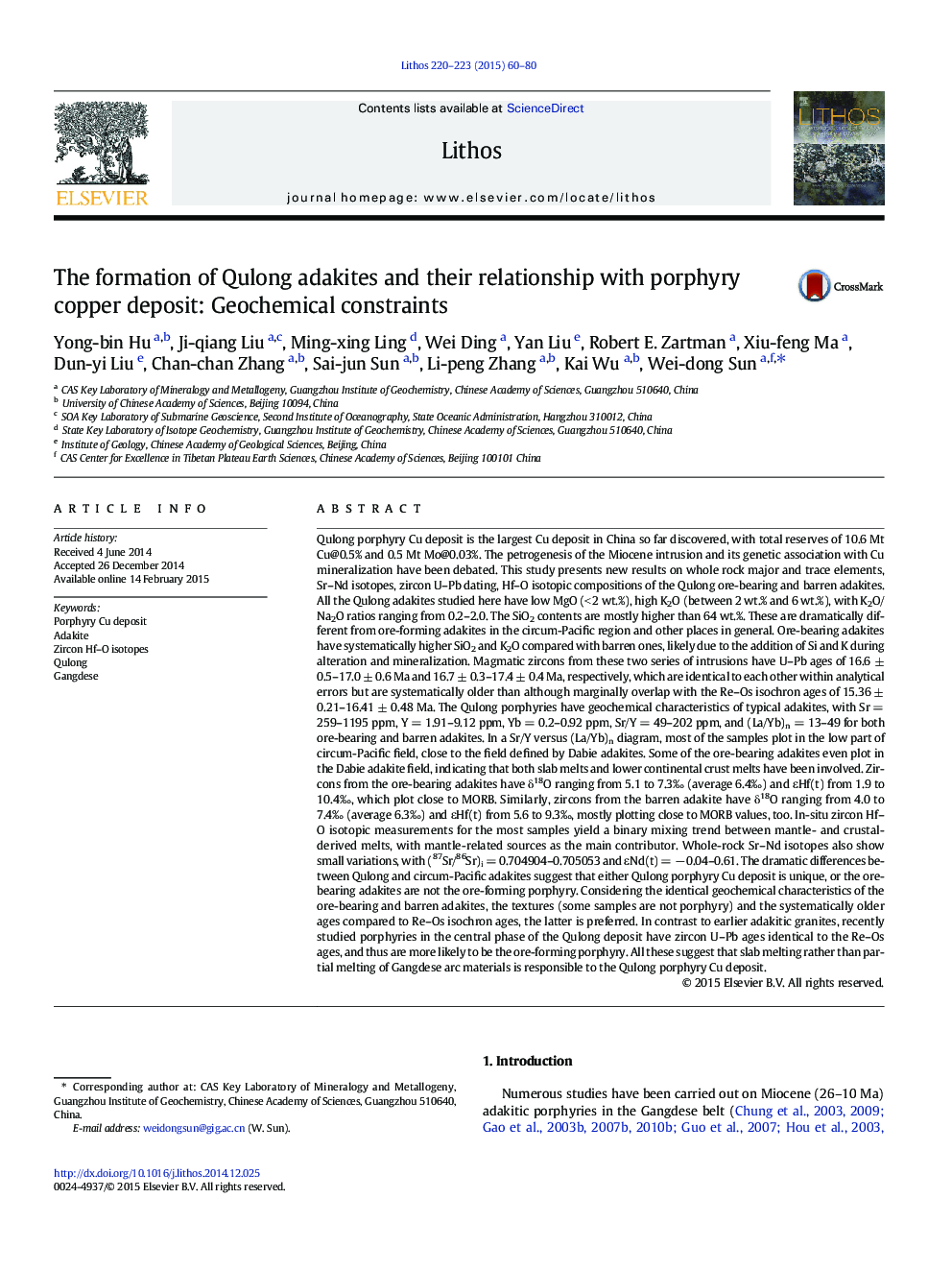| کد مقاله | کد نشریه | سال انتشار | مقاله انگلیسی | نسخه تمام متن |
|---|---|---|---|---|
| 4715702 | 1638666 | 2015 | 21 صفحه PDF | دانلود رایگان |

• Qulong is the largest porphyry copper deposit closely related to adakites formed in post-collisional period in Tibet.
• Qulong adakites have continental crust components.
• The adakitic porphyry in the central phase is responsible to the mineralizations, not the ore-bearing nor barren granites.
Qulong porphyry Cu deposit is the largest Cu deposit in China so far discovered, with total reserves of 10.6 Mt Cu@0.5% and 0.5 Mt Mo@0.03%. The petrogenesis of the Miocene intrusion and its genetic association with Cu mineralization have been debated. This study presents new results on whole rock major and trace elements, Sr–Nd isotopes, zircon U–Pb dating, Hf–O isotopic compositions of the Qulong ore-bearing and barren adakites. All the Qulong adakites studied here have low MgO (< 2 wt.%), high K2O (between 2 wt.% and 6 wt.%), with K2O/Na2O ratios ranging from 0.2–2.0. The SiO2 contents are mostly higher than 64 wt.%. These are dramatically different from ore-forming adakites in the circum-Pacific region and other places in general. Ore-bearing adakites have systematically higher SiO2 and K2O compared with barren ones, likely due to the addition of Si and K during alteration and mineralization. Magmatic zircons from these two series of intrusions have U–Pb ages of 16.6 ± 0.5–17.0 ± 0.6 Ma and 16.7 ± 0.3–17.4 ± 0.4 Ma, respectively, which are identical to each other within analytical errors but are systematically older than although marginally overlap with the Re–Os isochron ages of 15.36 ± 0.21–16.41 ± 0.48 Ma. The Qulong porphyries have geochemical characteristics of typical adakites, with Sr = 259–1195 ppm, Y = 1.91–9.12 ppm, Yb = 0.2–0.92 ppm, Sr/Y = 49–202 ppm, and (La/Yb)n = 13–49 for both ore-bearing and barren adakites. In a Sr/Y versus (La/Yb)n diagram, most of the samples plot in the low part of circum-Pacific field, close to the field defined by Dabie adakites. Some of the ore-bearing adakites even plot in the Dabie adakite field, indicating that both slab melts and lower continental crust melts have been involved. Zircons from the ore-bearing adakites have δ18O ranging from 5.1 to 7.3‰ (average 6.4‰) and εHf(t) from 1.9 to 10.4‰, which plot close to MORB. Similarly, zircons from the barren adakite have δ18O ranging from 4.0 to 7.4‰ (average 6.3‰) and εHf(t) from 5.6 to 9.3‰, mostly plotting close to MORB values, too. In-situ zircon Hf–O isotopic measurements for the most samples yield a binary mixing trend between mantle- and crustal-derived melts, with mantle-related sources as the main contributor. Whole-rock Sr–Nd isotopes also show small variations, with (87Sr/86Sr)i = 0.704904–0.705053 and εNd(t) = − 0.04–0.61. The dramatic differences between Qulong and circum-Pacific adakites suggest that either Qulong porphyry Cu deposit is unique, or the ore-bearing adakites are not the ore-forming porphyry. Considering the identical geochemical characteristics of the ore-bearing and barren adakites, the textures (some samples are not porphyry) and the systematically older ages compared to Re–Os isochron ages, the latter is preferred. In contrast to earlier adakitic granites, recently studied porphyries in the central phase of the Qulong deposit have zircon U–Pb ages identical to the Re–Os ages, and thus are more likely to be the ore-forming porphyry. All these suggest that slab melting rather than partial melting of Gangdese arc materials is responsible to the Qulong porphyry Cu deposit.
Journal: Lithos - Volumes 220–223, April 2015, Pages 60–80